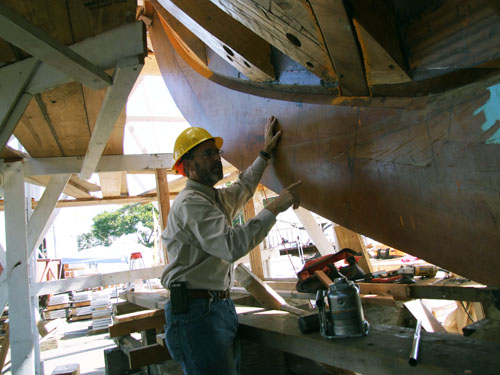
By Donald H. Harrison

SAN DIEGO — When people ask carpenter David Swanson how big the ship now under construction on a parking lot at Spanish Landing will be, he responds, “Oh, about 30 cubits by 40 cubits.” It was probably a coincidence that his allusion relates to “Noach,” this upcoming weekend’s Torah portion.
And, if someone should ask how the ship under construction will be put into the water, Swanson grins, winks, and says, “there’s going to be a big flood.”
With a gray beard that seems to be almost mandatory for local ship builders, if you were to put Swanson — “Suwanee” to his friends — in a biblical style robe, the carpenter might just pass for Noah.

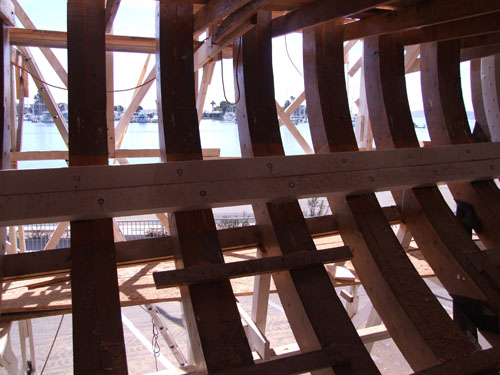
But, in actuality, the original of the historic ship replica on which he and other workers and volunteers for the San Diego Maritime Museum are laboring in a $6 million project was built thousands of years after Noah’s Ark. San Salvador was a 25-foot-wide, 80-foot-long galleon with a 12-foot spar that was utilized in 1542 by a Portuguese-born sailor, Juan Rodriguez Cabrillo, to explore and claim the coast of Upper California for Spain.
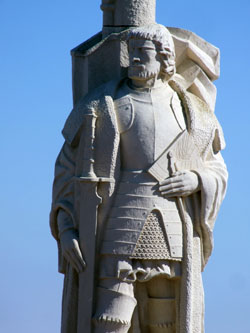
“Spanish Landing” where the slightly less than 200-U.S.-ton ship is being built was not named for the site of Cabrillo’s landfall, nor for that of explorer Sebastian Vizcaino, who came here in 1602 and called the area “San Diego.” (Cabrillo had called this area “San Miguel.”) Instead, Spanish Landing was named after the expedition in 1769 headed by Father Junipero Serra and Gov. Gaspar de Portola in an approximation of the spot where colonizers who came overland from Mexico rendezvoused with ships that carried the expedition’s supplies.
All this is explained by on-site educators in a cooperative project of the San Diego Maritime Museum and the Cabrillo National Monument. Tourists may view for $5 per person daily from 11 a.m. to 4:30 p.m. the shipbuilding from behind ropes. They may also visit tents with historic artifacts and enjoy occasional visits from costumed 16th-century characters, including “the Juan and the only” Juan Rodriguez Cabrillo.
Although the story of Cabrillo’s ship is not a “Jewish story” per se–the explorer was, after all, a Roman Catholic — the project has its interesting Jewish angles, demonstrating why this publication’s motto is “There’s a Jewish story everywhere.” For example, project manager Bruce Heyman relates that his Jewish father, who was a DuPont chemical engineer, used to move the family around the country on various assignments, including one in Orange, Texas. That’s where, when he was a boy, Heyman built a sailboat with his father, which they were able to float out of their driveway after one particularly memorable hurricane.
No flood waters will be required for San Salvador‘s launching, Heyman said. They plan either to roll the ship on dollies to the side of the bay and then have it lifted into the water by a floating crane, or they will put it on a large truck and drive it along the streets –similar to the way that the space shuttle Endeavour recently journeyed through Los Angeles–en route to a suitable boat ramp, possibly at the nearby Coast Guard station.
Although shipbuilding continued to be a hobby for Heyman, he had a career as an electrical engineer working for Motorola, with assignments in various parts of the world, including in Arad, Israel, where he worked on communications systems enabling the IDF and U.S. military forces in the region to liaise.
When he retired in 2006 from Motorola, he took up nautical pursuits full time, helping to maintain two tall ships at Dana Point, California: Pilgrim named for the two-masted snow-brig that adventurer Richard Henry Dana, author of Two Years Before the Mast, sailed on in the 1830s, and Spirit of Dana Point. Heyman was recruited in 2011 by the San Diego Maritime Museum’s executive director Ray Ashley to work on this project, eventually becoming the director of 12 paid staff and numerous volunteers.
As Heyman and I chatted, site educators Jody Wilson and Katie Quezada dropped into Heyman’s construction trailer, and both had their own Jewish stories to tell. Wilson’s school-aged daughter recently had served as a youth ambassador, visiting Tel Aviv and Jerusalem to talk about life in the United States. And Quezada recently learned through ancestry.com that she was descended from Sephardic Jews, and now is researching to learn more about that portion of her family tree.
When my conversation with Heyman resumed, he told me that because of U.S. Coast Guard regulations, as well as those of Lloyds of London insurance agency, there are many differences between Cabrillo’s ship and the one he is building, even though their exteriors may seem similar. No one knows precisely what Cabrillo’s ship looked like, as there were no blueprints, nor precise descriptions handed down. Over the years, nautical historians have made informed guesses about what San Salvador looked like, but these have not remained constant. In fact, in the museum at Cabrillo National Monument, visitors are able to see one model and at the shipbuilding site a more recent model.
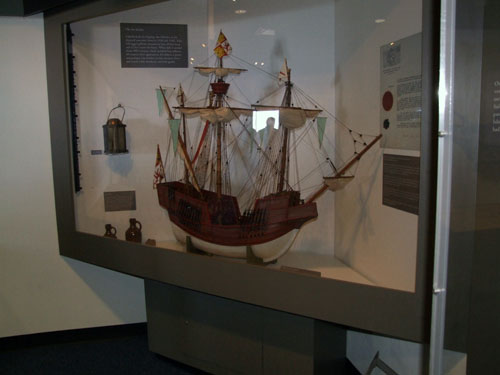
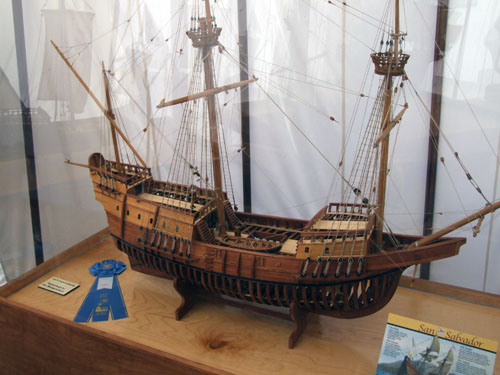
Whereas Cabrillo had to rely on locally grown trees, the shipwrights for the San Salvador replica have been utilizing woods from around the world based on desired qualities. Heyman listed them and where they will be used on the ship as follows:
“White Oak – sole (floors down below); Southern Live Oak – futtocks that make up the ribs or frames; Angelique – keel; Apitong – transom frame and dead wood; Purple Heart – rudder, keelson, engine and tank beds, stern posts, and transom parts; Hackmatack – hanging knees, lodging knees, and breast hooks; Sapele – stem, gripe, and hull planking; Alaskan Yellow Cedar – top timbers; Black Locust – tree nails or trunnels; and Doug Fir – deck planking, hull planking above the water lines, bilge stringer, beam shelves, clamps, deck beams, carlings, and lodging knees.”
The interior spaces of the replica, of necessity, will be quite a bit different from Cabrillo’s ship, and that’s a good thing. The keel is ballasted with lead forms that will stay in place no matter how much the wind or the waves tip the ship, meaning that it will more easily right itself than Cabrillo’s ship ever could. His ship was ballasted with stones that could move from place to place inside the ship, changing the centers of buoyancy and gravity, and making the ship more liable to sink. The replica also will have four water-tight bulkheads. “Any one of them could be flooded and the ship will remain stable and viable,” Heyman said.
There will also be three flush toilets, and even a shower, aboard the replica, which is intended to offer passenger excursions. In Cabrillo’s day, when they had no such contrivances, sailors took care of their bodily needs over the sides of the ship, and, no, not from the “poop deck,” which was quite a bit higher than the main deck.
Another difference is that the replica will not only have its sails but also two John Deere turbo-diesel engines for maneuvering in and out of the harbor.
“If you think back to 1542 you didn’t need to dock the boat,” Heyman said. “There were no docks. You anchored way away because if a storm came in you didn’t want to get blown to shore.” On the other hand, the replica has “to meet schedules, we have to be on and off docks, and we have to be able to maneuver so as not to hit aircraft carriers going in and out of the harbor.”
Various excursions are planned, including some retracing portions of Cabrillo’s three-month-long voyage to San Diego from Navidad, Mexico, Heyman said. While it initially had been hoped that the vessel could be completed before September 28th — the day in 1542 that Cabrillo sailed into the harbor — more realistic estimates are that it will be finished in December of this year or January of next year.
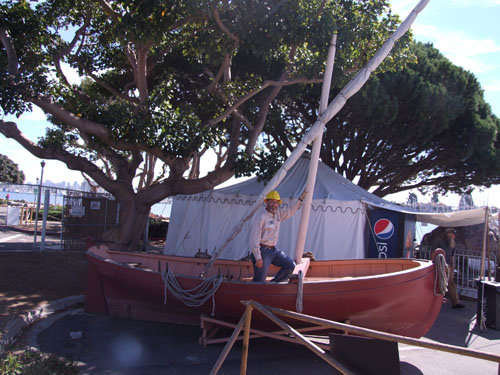
Assuming that’s the case, the San Salvador replica will sail into San Diego Harbor on Sept. 28, 2013, and will lower the longboat Chalupa which will make its way to the shore for a ceremony reenacting Cabrillo’s landing. Waiting to greet him will be living descendants of the Kumeyaay Indians, who followed semi-nomadic lives in San Diego County for thousands of years before his arrival.
Spanish Landing was built on reclaimed land dredged up from the harbor years ago to accommodate deep-draft ships, including the large Navy vessels that make their homeports in San Diego. When trucks go over a nearby bridge, the reclaimed land shakes under the San Salvador newbuilding, requiring the ship to be re-leveled every so often.
As the project has continued, there have been various unexpected events — for example, certain laminated frames purchased from a vendor peeled and had to be replaced. Heyman said the motto of the yard is “success is how well you deal with Plan B.”
Even as the ship is being built, fundraising is continuing, with approximately $4 million of the $6 million raised, according to Heyman. He described the ongoing project as one that is very much a matter of San Diego pride, with San Diegans supplying the capital, some materials, and the volunteer and professional labor force.
*
Harrison is editor of San Diego Jewish World. He may be contacted at donald.harrison@sdjewishworld.com